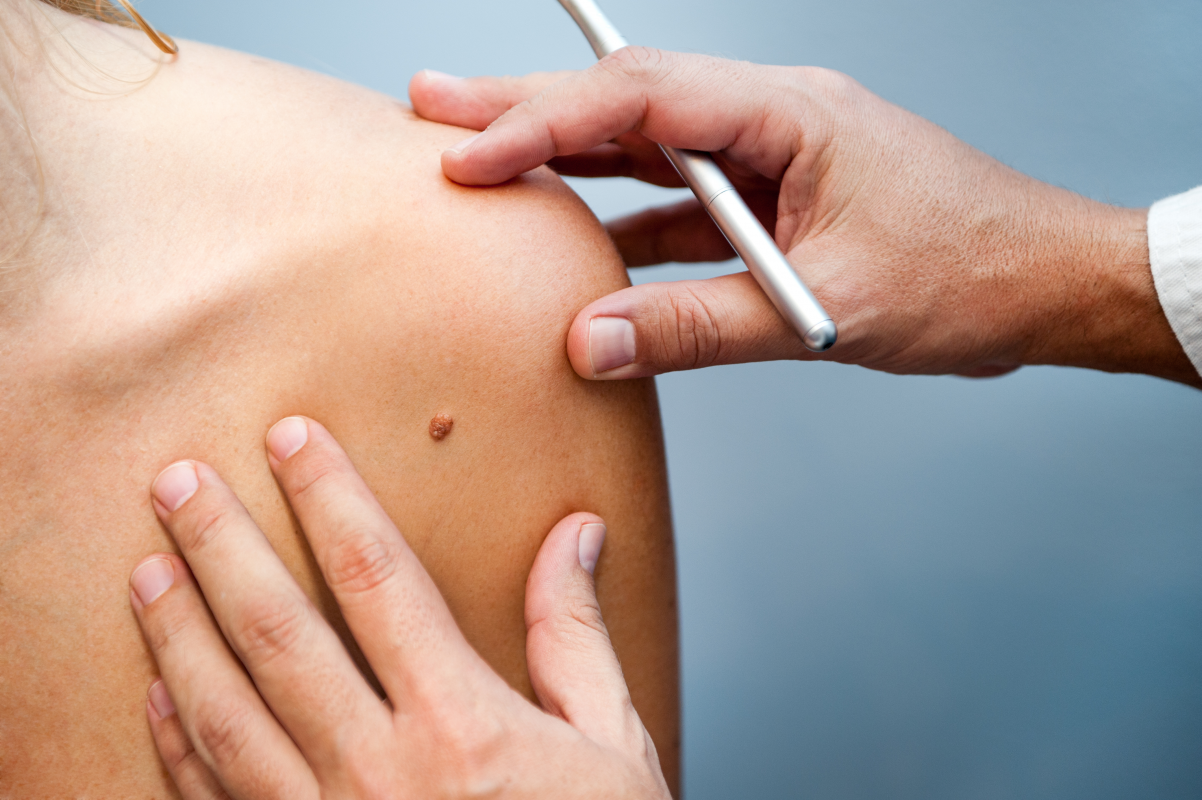South Africa has one of the highest diagnoses of malignant melanoma globally, causing growing concern for South Africans and skin cancer overall. South Africans are more prone to skin cancer due to our nation’s latitude and exposure to high ambient solar ultraviolet radiation year-round.
Some demographics are more prone to skin cancer than others. For example, darker skin pigmentation has more natural protection from the sun. So the lighter a person’s skin tone, the more susceptible that person is to getting skin cancer. But this doesn’t mean darker skin tones are immune. Skin cancer and melanoma do not discriminate and can occur in anyone, regardless of the pigmentation of their skin.
What Is Melanoma?
Melanoma is a type of skin cancer that develops when the melanocyte cells that give your skin its color start to grow out of control. It’s less common than other skin cancers but more dangerous. If melanoma isn’t caught and treated early, it is very likely to spread to other parts of the body, making early detection crucial.
Five Signs of Melanoma
So, how can you stay vigilant and catch potential cases of melanoma sooner rather than later?
Look for any new, changing, or unusual marks on your skin — whether or not that patch of skin has been exposed to the sun. Melanoma can appear anywhere. That said, it can be more common on women’s legs and men’s torsos.
There are five major signs to look for when checking for melanoma. These are referred to as the ABCDEs of skin cancer.
#1 Asymmetry
One half of the spot is different from the other half.
#2 Border
The spot has an irregular, scalloped, or poorly defined border.
#3 Color
The spot has various colors within the same area, including varying shades of tan, brown, black, or sites that appear red, white, or blue.
#4 Diameter
Typically, melanomas are approximately the size of a pencil eraser, but they can also be smaller.
#5 Evolving
The spot either looks different from other spots on the skin or has been noticeably changing in size, shape, or color.
Other Signs
Be watchful of any new moles, freckles, or spots that show up on your skin. Consult a dermatologist if a sore does not heal or anything else on your skin that looks unusual.
Although most moles and growths are harmless, perform monthly self-checks and see a dermatologist annually.
Diagnosis
The only way to make a definitive melanoma diagnosis is with a biopsy. In this procedure, doctors extract a small amount of tissue or a cell sample from the site in question. Called a lesion, this sample is removed and sent to a laboratory to be analyzed.
Your healthcare provider will first numb the area with a local anesthetic to block any pain from the procedure. They will then remove all or part of the suspicious skin growth, taking care to preserve the entire lesion so it can be properly examined.
The lesion is then sent to a pathologist or dermatopathologist to determine if melanoma is present. Once testing is complete, a pathology report will be written and sent to your doctor. They will contact you with the results.
Treating Melanoma By the Stages
If your biopsy shows that melanoma is present, you will receive a diagnosis in one of five stages. Each stage has its own procedures and treatment recommendations.
Stage 0
Stage 0 is the least severe stage. At this point, the melanoma has not grown any deeper than the top layer of skin and can usually be treated with a wide excision to remove the infected skin and a small buffer of normal skin around it.
Stage I
Stage I is typically treated in the same way as stage 0, with surgery that removes both the melanoma and a margin of unaffected skin surrounding it. The width of the margin will depend on the thickness and location of the melanoma. Usually, no other treatment is needed, but some physicians will recommend a sentinel lymph node biopsy (SLNB) to check for cancer in nearby lymph nodes.
Stage II
Stage II follows the same procedures as in stage I, although follow-ups are highly recommended, even after successful removal.
Stage III
Being diagnosed with Stage III melanoma means that cancer has already been found in the lymph nodes. On top of excising the primary tumor, doctors will also perform a lymph node dissection. After these surgeries, follow-up treatment is implemented to help lower the risk of melanoma returning.
Stage IV
Stage IV melanomas have already metastasized, meaning they’ve spread to lymph nodes or other areas of the body. The usual treatment involves surgery to remove these tumors and lymph nodes, followed by radiation therapy. Affected organs may also have to be removed, followed by more treatment that could include targeted drugs, immunotherapies, chemotherapy, or a combination.
Local Recurrence
It is always a possibility that melanoma might come back near the site of the original tumor. Generally, these skin recurrences are treated with wide excision surgery and perhaps an SLNB to be on the safe side. Depending on your results, the doctor might also recommend other treatments.
Follow-Up Care
Even after active treatment has concluded, your healthcare team will continue to provide support. They will check that cancer has not returned, help manage any side effects from the treatment, and monitor your overall health. Their recommendations can include a wide range of services, such as physical or occupational therapy, nutritional planning, and pain management.
This follow-up care may also be referred to as surveillance or monitoring. The goal is to help patients remain as independent as possible and regain control over their lives again.
Skin Cancer Prevention
Although melanoma is rampant in South Africa, there are ways to lower your risk:
- Stay in the shade as much as possible.
- Use a broad-spectrum UVA/UVB sunscreen every day to avoid getting sunburned.
- Avoid tanning naturally and with UV tanning beds.
- Cover your skin with clothing, wear a wide-brimmed hat, and use UV-blocking sunglasses.
Aynjil Insurance
Even if you follow every prevention tip, there is no 100% surefire way to prevent skin cancer and melanoma. That’s why at Aynjil, we offer specialized cancer insurance with benefits to support you through every step of cancer diagnosis and treatment. Our revolutionary product is specially designed to augment your current health insurance, providing the most comprehensive cancer cover on the market.
We know that a cancer diagnosis not only comes with added financial expenses but also takes a toll on your emotional and physical wellbeing. We offer services to assist you with these lifestyle changes so that you can focus on your treatment.
In an effortless 4-minute online process, you can be signed up and ready to face your cancer diagnosis head-on. Just visit our website to learn more about Aynjil’s benefits and to sign up today.
Marketing by Joseph Studios



